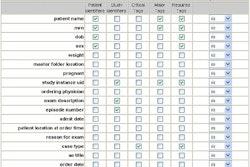Converting emergency departments to filmless operations yields time savings and workflow improvements, and can serve as a stepping stone for the introduction of hospital-wide PACS, according to Dr. John Wandtke, medical director for PACS at the University of Rochester Medical Center in Rochester, NY.
"(The ED) is a great place to start with PACS," he said. "It's a very controlled, self-contained area, and it's very easy to monitor what's going on and see cost savings, both in time and film. It's good not only for the ED physicians, but also for the radiologists."
Wandtke discussed URMC's more than two years of experience employing filmless radiology at Strong Memorial Hospital’s emergency department during a talk at the PACS 2003: Integrating the Healthcare Enterprise conference in San Antonio, sponsored by the University of Rochester School of Medicine and Dentistry in Rochester, NY.
Strong Memorial Hospital’s ED handles more than 60,000 computed radiography exams and over 22,000 CT studies a year, and has 30 x-ray technologists and 40 radiologists on staff. The ED operation includes about 100 beds and six clinical areas, each with a dedicated physician group.
Emergency radiology attending physicians are on hand from 7 a.m. to 9 p.m., interpreting plain-film exams and coordinating emergency studies. From 9 p.m. to 7 a.m., radiology residents interpret the plain films, CT, and ultrasound, as well as teleradiology exams from a nearby hospital, Wandtke said.
Stat or preliminary reports are typed into a PACS workstation and are immediately available to the emergency room physician via an "image notes" button along with the image, Wandtke said. And implementation of speech recognition will allow for delivery of the full report along with the image, he said.
Phone calls are made now only for extremely complex reports such as some CT studies, and at night, all residents are available via the institution's wireless phone system for consultation.
CT, MRI, ultrasound, and nuclear medicine studies are interpreted via the PACS workstation by attending radiologists in the main radiology department from 8 a.m. to 5 p.m., and by the radiology resident and fellow from 5 p.m. to 8 a.m.
ED radiologists utilize high-resolution workstations for image reading and reporting, while ED physicians and staff use readily available PC-based workstations for viewing studies, he said. Radiologists provided crucial workstation training to the ED staff, which includes 20 attending ED physicians, 24 ED residents, 50 specialists (trauma surgeons, pediatricians, internist, etc.), 12 nurse practitioners, and 15 medical students, Wandtke said.
"We had a lot of training to do so they (could) use these workstations quickly and easily," he said.
After the radiologist interprets the study, a hard copy is available if the patient is going to the operating room, since there aren't enough viewers in the OR yet, Wandtke said. A hard copy or a CD can be provided if the patient is going to another hospital or clinic.
The filmless approach has won big fans among the ED physicians, bringing them significant time savings and workflow gains, Wandtke said. Consultant physicians, such as trauma surgeons and neurosurgeons, also enjoy the ability to access studies after hours via a Web browser before having to come in to the institution, he said. And the radiologists provide much faster reports.
Advantages
In addition to providing immediate access to current images and reports, filmless emergency radiology has proved valuable in complex cases, allowing for prompt access to comparison films from the past two years. In contrast, the old system of access films from basement storage took no less than 20 to 30 minutes, he said.
Orthopedic residents can take advantage of the PACS to consult remotely with their attendings in the clinics or the OR, and radiology attendings are also now quickly available for consultation with the ED radiologist, he said. In addition, the system enables radiology residents to use the PACS Web browser as a teleradiology method for nights and weekends to consult with the attending radiologist.
"We've had some situations where the residents have not consulted, and we've told them, when this case comes up next time, call the attending radiologist at home and ask them what they think about this aneurysm or bowel obstruction or appendicitis situation," Wandtke said. "There are a lot of cases in radiology that are abnormal, but surprisingly there are a good number of cases in the gray zone. And only the most experienced people can make the right call. Having teleradiology to support our residents at night has become something that we think is extremely valuable for improvement of care."
The system's "review list" feature, which earmarks cases requiring consultation, allows radiology residents to quickly review cases with the attending radiologist.
Disadvantages
Of course, no system is perfect. Because the ED physicians don't use 2K x 2K workstations, they may not be able to see subtle findings.
"Sometimes I actually put arrows on things to help them, knowing that their monitors are not as high a resolution as what I had," Wandtke said.
The ED physicians may also see images before the radiologist and the report, and radiologists don't know if the ED physician has interpreted the image and acted on the findings, he said. Also, human errors such as mislabeling of study type and misidentification of patients are not eliminated with the system.
There's also no electronic means for ED physicians to give feedback, such as their preliminary report, to radiologists. And there's no quality assurance system in place to follow up on discrepancies, he said.
Overall, however, conversion of emergency radiology services to filmless operations can be a highly worthwhile endeavor, Wandtke said. And having a positive experience with digital image management in one area of the hospital can go a long way towards winning institutional support for broader implementation of PACS.
"Getting clinicians to buy in to this was a difficult task at first, but once they saw all the advantages, it was easy then to get support from hospital administration to get the money to expand the program hospital-wide," Wandtke said.
By Erik L. RidleyAuntMinnie.com staff writer
May 9, 2003
Related Reading
Use of e-signatures requires awareness of legal ramifications, March 28, 2003
PACS archive techniques continue to evolve, March 18, 2003
PACS sparks increase in hospital revenue, February 21, 2003
Offsite ASP archive fulfills disaster-recovery, backup requirements, January 21, 2003
PACS firms integrate, broaden product lines, November 18, 2002
Copyright © 2003 AuntMinnie.com




















